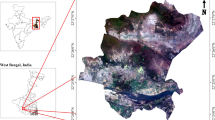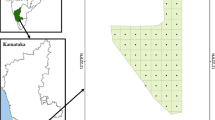Abstract
The determination of soil properties, in addition to requiring great human effort, also involves a number of technical activities of high financial cost. Seeking to show that it is possible to reduce these high financial costs, this study presents a methodology that combines remote sensing techniques and mathematical modeling for estimating the concentration of soil organic matter (SOM). Technological advances have provided great improvements in equipment for capturing terrestrial information, allowing a greater availability of quality data for spatial analysis, which has brought about better estimates in the models. Thus, this study evaluated the capacity of the Sentinel-1 Synthetic Aperture Radar (SAR) satellite to determine the concentration of SOM in areas with different types of agricultural use in a hydrographic basin localted in the souutheastern region of the state of São Paulo, Brazil. The partial least squares regression method was used to build models for estimating the SOM, taking into account the SAR backscattering values and soil samples obtained in situ, which were collected at a depth of 0–10 cm. The results obtained indicated that the accuracy of the model adjusted based on backscattering values in the vertical/vertical (VV), vertical/horizontal (VH) polarizations, product of VHxVV and soil moisture presented a coefficient of determination of 0.502 with the SOM for independent data, at p <0.0001. These results indicate that the model derived from the SAR data for the map** of SOM presented potential for prediction, but only within acceptable limits for predicting SOM in areas with similar characteristics of land use.





Similar content being viewed by others
References
Arrouays D, Lagacherie P, Hartemink AE (2017) Digital soil map** across the globe. Geoderma Reg 9:1–4. https://doi.org/10.1016/j.geodrs.2017.03.002
Bartsch A, Widhalm B, Kuhry P, Hugelius G, Palmtag J, Siewert MB (2016) Can C-band synthetic aperture radar be used to estimate soil organic carbon storage in tundra? Biogeosciences 13:5453–5470. https://doi.org/10.5194/bg-13-5453-2016
Braun A (2020) Sentinel-1 Toolbox. Sinergetc use of radar and aptical data: combination of Sentinel-1 and Sentinel-2 and application of analysis tools, European Space Agency-ESA. Retrieved 10 February 2020 from: https://step.esa.int/docs/tutorials/S1TBX%20Synergetic%20use%20of%20S1%20(SAR)%20and%20S2%20(optical)%20data%20Tutorial.pdf
Camargo OA, Moniz AC, Jorge JA, Valadares JMAS (2009) Métodos de Análise Química, Mineralógica e Física de Solos do Instituto Agronômico de Campinas. Boletim técnico, Ed, Campinas, Instituto Agronômico/Fundação, p 77–106.Retrieved 23 December 2023 from: https://www.iac.sp.gov.br/produtoseservicos/analisedosolo/docs/Boletim_Tecnico_106_rev_atual_2009.pdf
Campbell PMDM, Francelino MR, Fernandes EI et al (2019) Digital map** of soil attributes using machine learning. Rev Ciênc Agron 50:519–528. https://doi.org/10.5935/1806-6690.20190061
Chen D, Chang N, ** dynamics of soil organic matter in croplands with MODIS data and machine learning algorithms. Sci Total Environ 669:844–855. https://doi.org/10.1016/j.scitotenv.2019.03.151
DAEE - Departamento de Água e Energia Elétrica. Dados históricos de chuva, São Paulo. Retrieved 13 April 2020 from: http://sibh.daee.sp.gov.br/
de Souza JC, Lopes ERDN, de Sousa JAP, Lourenço RW (2018) Avaliação dos aspectos físico-químicos dos solos em diferentes coberturas vegetais. Braz J Environ Sci (RBCIAMB):123–139. https://doi.org/10.5327/Z2176-947820180366
Dragulescu and Arendt C (2022) xlsx: Read, Write, Format Excel 2007 and Excel 97/2000/XP/2003 Files. Retrieved 13 April 2020 from: https://cran.r-project.org/web/packages/xlsx/xlsx.pdf
Duarte ML, da Filho Silva EP, Costa HS, da Silva TA (2021) Soil Erosion Assessment Using RUSLE Model and GIS in Juma Watershed, Brazilian Amazon. Rev Bras Geogr Fís 14:2931–2945. https://doi.org/10.26848/rbgf.v14.5.p2931-2945
EMBRAPA (1997) Manual de métodos de análise de solos. Centro Nacional de Pesquisa de Solos. 2ª ed. Rio de Janeiro, 212p. Retrieved 16 April 2020 from: https://www.infoteca.cnptia.embrapa.br/bitstream/doc/990374/1/ManualdeMtodosdeAnilisedeSolo.pdf
ESA SNAP Esa Sentinel Application Platform. V. 2.0.2. Retrieved 23 April 2020 from: https://step.esa.int/main/download/snap-download/
ESA Copernicus Open Access Hub. Dados Sentinel-1. Retrieved 10 April 2020 from: https://dataspace.copernicus.eu/browser/
Fletcher TD (2022) QuantPsyc: Quantitative Psychology Tools. Retrieved 10 April 2020 from: https://cran.r-project.org/web/packages/QuantPsyc/QuantPsyc.pdf
Gholizadeh A, Saberioon M, Viscarra Rossel RA, Boruvka L, Klement A (2020) Spectroscopic measurements and imaging of soil colour for field scale estimation of soil organic carbon. Geoderma 357:113972. https://doi.org/10.1016/j.geoderma.2019.113972
Grunwald S, Thompson JA, Boettinger JL (2011) Digital Soil Map** and Modeling at Continental Scales: Finding Solutions for Global Issues. Soil Sci Soc Am J 75:1201–1213. https://doi.org/10.2136/sssaj2011.0025
Hengl T, de Jesus JM, Heuvelink GBM, Gonzalez MR, Kilibarda M, Blagotić SW, Wright MN, Geng X, Bauer-Marschallinger B, Guevara MA, Vargas R, MacMillan RA, Batjes NH, Leenaars JGB, Ribeiro E, Wheeler I, Mantel S, Kempen B (2017) SoilGrids250m: Global gridded soil information based on machine learning. PLoS One 12:e0169748. https://doi.org/10.1371/journal.pone.0169748
Lamichhane S, Kumar L, Wilson B (2019) Digital soil map** algorithms and covariates for soil organic carbon map** and their implications: A review. Geoderma 352:395–413. https://doi.org/10.1016/j.geoderma.2019.05.031
Lee J-S, Wen J-H, Ainsworth TL, Chen KS, Chen AJ (2009) Improved Sigma Filter for Speckle Filtering of SAR Imagery. IEEE T Geosci Remote 47:202–213. https://doi.org/10.1109/TGRS.2008.2002881
Liland KH, Mevik B-H, Wehrens R, Hiemstra P (2023) pls: Partial Least Squares and Principal Component Regression. Retrieved 10 April 2020 from: https://cran.r-project.org/web/packages/pls/pls.pdf
Luo C, Zhang W, Zhang X, Liu H (2024) Map** the soil organic matter content in a typical black-soil area using optical data, radar data and environmental covariates. Soil Tillage Res 235:105912. https://doi.org/10.1016/j.still.2023.105912
Mallick J, Ahmed M, Alqadhi SD et al (2022) Spatial stochastic model for predicting soil organic matter using remote sensing data. Geocarto Int 37:413–444. https://doi.org/10.1080/10106049.2020.1720314
Mulder VL, de Bruin S, Schaepman ME, Mayr TR (2011) The use of remote sensing in soil and terrain map** — A review. Geoderma 162:1–19. https://doi.org/10.1016/j.geoderma.2010.12.018
Ondrasek G, Bakić Begić H, Zovko M, Filipović L, Meriño-Gergich C, Savić R, Rengel Z (2019) Biogeochemistry of soil organic matter in agroecosystems & environmental implications. Sci Total Environ 658:1559–1573. https://doi.org/10.1016/j.scitotenv.2018.12.243
Polat AB, Akcay O, Balik Sanli F (2022) Monitoring seasonal effects in vegetation areas with Sentinel-1 SAR and Sentinel-2 optic satellite images. Arab J Geosci 15:670. https://doi.org/10.1007/s12517-022-09947-x
R Core Team (2020) R: A language and environment for statistical computing. R Foundation for Statistical Computing, Vienna, Austria Retrieved 10 April 2020 from: https://www.r-project.org/
Rodell M, Houser PR, Jambor U, Gottschalck J, Mitchell K, Meng C-J, Arsenault K, Cosgrove B, Radakovich J, Bosilovich M, Entin JK, Walker JP, Lohmann D, Toll D (2004) The Global Land Data Assimilation System. B AM Meteorol Soc 85:381–394. https://doi.org/10.1175/BAMS-85-3-381
Shafizadeh-Moghadam H, Minaei F, Talebi-khiyavi H, Xu T, Homaee M (2022) Synergetic use of multi-temporal Sentinel-1, Sentinel-2, NDVI, and topographic factors for estimating soil organic carbon. Catena 212:106077. https://doi.org/10.1016/j.catena.2022.106077
Silva DCDCE, Albuquerque Filho JL, Sales JCA, Lourenço RW (2017) Identificação de áreas com perda de solo acima do tolerável usando NDVI para o cálculo do fator C da USLE. Rev Ra’e Ga 42:72. https://doi.org/10.5380/raega.v42i0.45524
Silva DCDCE, Filho JLA, Sales JCA, Lourenço RW (2016) Uso de Indicadores Morfométricos como Ferramentas para Avaliação de Bacias Hidrográficas (Use of Morphometric Indicators as Tools for Assessment Watershed). Rev Bras Geogr Fís 9:627–642. https://doi.org/10.26848/rbgf.v9.2.p627-642
Tripathi A, Tiwari RK (2022) Utilisation of spaceborne C-band dual pol Sentinel-1 SAR data for simplified regression-based soil organic carbon estimation in Rupnagar, Punjab, India. Adv Space Res 69:1786–1798. https://doi.org/10.1016/j.asr.2021.08.007
Tziachris P, Aschonitis V, Chatzistathis T, Papadopoulou M (2019) Assessment of spatial hybrid methods for predicting soil organic matter using DEM derivatives and soil parameters. Catena 174:206–216. https://doi.org/10.1016/j.catena.2018.11.010
Vaudour E, Gholizadeh A, Castaldi F, Saberioon M, Borůvka L, Urbina-Salazar D, Fouad Y, Arrouays D, Richer-de-Forges AC, Biney J, Wetterlind J, Van Wesemael B (2022) Satellite Imagery to Map Topsoil Organic Carbon Content over Cultivated Areas: An Overview. Remote Sens 14:2917. https://doi.org/10.3390/rs14122917
Viglizzo EF, Ricard MF, Taboada MA, Vázquez-Amábile G (2019) Reassessing the role of grazing lands in carbon-balance estimations: Meta-analysis and review. Sci Total Environ 661:531–542. https://doi.org/10.1016/j.scitotenv.2019.01.130
Wali E, Tasumi M, Moriyama M (2020) Combination of Linear Regression Lines to Understand the Response of Sentinel-1 Dual Polarization SAR Data with Crop Phenology—Case Study in Miyazaki, Japan. Remote Sens 12:189. https://doi.org/10.3390/rs12010189
Warrick AW, Nielsen DR (1980) 13 - Spatial Variability of Soil Physical Properties in the Field. In: Hillel D (ed) Applications of Soil Physics. Academic Press, pp 319–344. https://doi.org/10.1016/B978-0-12-348580-9.50018-3
Wickham H, François R, Henry L, Müller K (2023) dplyr: A grammar of data manipulation, New York. Retrieved 10 April 2020 from: https://cran.r-project.org/web/packages/dplyr/dplyr.pdf
Wiesmeier M, Urbanski L, Hobley E, Lang B, von Lützow M, Marin-Spiotta E, van Wesemael B, Rabot E, Ließ M, Garcia-Franco N, Wollschläger U, Vogel H-J, Kögel-Knabner I (2019) Soil organic carbon storage as a key function of soils - A review of drivers and indicators at various scales. Geoderma 333:149–162. https://doi.org/10.1016/j.geoderma.2018.07.026
Yang R-M, Guo W-W (2019) Using time-series Sentinel-1 data for soil prediction on invaded coastal wetlands. Environ Monit Assess 191:462. https://doi.org/10.1007/s10661-019-7580-3
Yin H, Chen C, He Y, Jia J, Chen Y, Du R, **ang R, Zhang X, Zhang Z (2023) Synergistic estimation of soil salinity based on Sentinel-1 image texture and Sentinel-2 salinity spectral indices. JARS 17:018502. https://doi.org/10.1117/1.JRS.17.018502
Yuzugullu O, Lorenz F, Fröhlich P, Liebisch F (2020) Understanding Fields by Remote Sensing: Soil Zoning and Property Map**. Remote Sens 12:1116. https://doi.org/10.3390/rs12071116
Zeileis A, Hothorn T (2002) Diagnostic Checking in Regression Relationships. R News 2:7–10 Retrieved 12 April 2020 from: https://cran.r-project.org/web/packages/lmtest/vignettes/lmtest-intro.pdf
Zhang Y, Guo L, Chen Y, Shi T, Luo M, Ju Q, Zhang H, Wang S (2019) Prediction of Soil Organic Carbon based on Landsat 8 Monthly NDVI Data for the Jianghan Plain in Hubei Province, China. Remote Sens 11:1683. https://doi.org/10.3390/rs11141683
Zhou T, Geng Y, Chen J et al (2020) Map** soil organic carbon content using multi-source remote sensing variables in the Heihe River Basin in China. Ecol Indic 114:106288. https://doi.org/10.1016/j.ecolind.2020.106288
Zhu H, Sun R, Xu Z, Chunjuan L, Bi R (2020) Prediction of Soil Nutrients Based on Topographic Factors and Remote Sensing Index in a Coal Mining Area, China. Sustainability 12:1626. https://doi.org/10.3390/su12041626
Acknowledgements
This study was supported by the Coordination for the Improvement of Higher Education Personnel – Brazil (CAPES) – Code Financing 001.
Author information
Authors and Affiliations
Contributions
Conceptualization: Miqueias Lima Duarte; Data modeling, validation and visualization: Miqueias Lima Duarte and Ricardo Luís Barbosa; Writing–original draft: Miqueias Lima Duarte and Ricardo Luís Barbosa; Supervision: Roberto Wagner Lourenço; writing–review and editing: Darllan Collins da Cunha e Silva and Roberto Wagner Lourenço.
Corresponding author
Ethics declarations
Conflict of interest
The authors declare no competing interests.
Additional information
Responsible Editor: Biswajeet Pradhan
Rights and permissions
Springer Nature or its licensor (e.g. a society or other partner) holds exclusive rights to this article under a publishing agreement with the author(s) or other rightsholder(s); author self-archiving of the accepted manuscript version of this article is solely governed by the terms of such publishing agreement and applicable law.
About this article
Cite this article
Duarte, M.L., da Cunha e Silva, D.C., Barbosa, R.L. et al. Modeling of soil organic matter using Sentinel-1 SAR and partial least squares (PLS) regression. Arab J Geosci 17, 32 (2024). https://doi.org/10.1007/s12517-023-11844-w
Received:
Accepted:
Published:
DOI: https://doi.org/10.1007/s12517-023-11844-w




